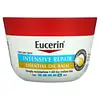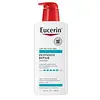What's inside
What's inside
 Key Ingredients
Key Ingredients

 Benefits
Benefits

 Concerns
Concerns

 Ingredients Side-by-side
Ingredients Side-by-side

Glycerin
HumectantDecyl Oleate
EmollientOctyldodecanol
EmollientRicinus Communis Seed Oil
MaskingButyrospermum Parkii Butter
Skin ConditioningC18-38 Alkyl Hydroxystearoyl Stearate
EmollientCaprylic/Capric Triglyceride
MaskingCetearyl Alcohol
EmollientDicaprylyl Carbonate
EmollientBis-Diglyceryl Polyacyladipate-2
EmollientHydrogenated Coco-Glycerides
EmollientCetyl Palmitate
EmollientPolyglyceryl-3 Diisostearate
EmulsifyingBeeswax
Emulsion StabilisingHydrogenated Castor Oil
EmollientUrea
BufferingGlycine
BufferingSodium PCA
HumectantArginine Hcl
Skin ConditioningSodium Ascorbyl Phosphate
AntioxidantTocopherol
AntioxidantHelianthus Annuus Seed Oil
EmollientWater
Skin ConditioningMagnesium Stearate
Cosmetic ColorantMagnesium Sulfate
Decylene Glycol
Skin ConditioningGlycerin, Decyl Oleate, Octyldodecanol, Ricinus Communis Seed Oil, Butyrospermum Parkii Butter, C18-38 Alkyl Hydroxystearoyl Stearate, Caprylic/Capric Triglyceride, Cetearyl Alcohol, Dicaprylyl Carbonate, Bis-Diglyceryl Polyacyladipate-2, Hydrogenated Coco-Glycerides, Cetyl Palmitate, Polyglyceryl-3 Diisostearate, Beeswax, Hydrogenated Castor Oil, Urea, Glycine, Sodium PCA, Arginine Hcl, Sodium Ascorbyl Phosphate, Tocopherol, Helianthus Annuus Seed Oil, Water, Magnesium Stearate, Magnesium Sulfate, Decylene Glycol
Paraffinum Liquidum
EmollientOctyldodecanol
EmollientCaprylic/Capric Triglyceride
MaskingIsopropyl Palmitate
EmollientSodium Lactate
BufferingUrea
BufferingGlycerin
HumectantPEG-7 Hydrogenated Castor Oil
EmulsifyingBenzyl Alcohol
PerfumingDimethicone
EmollientMethoxy PEG-22/Dodecyl Glycol Copolymer
Emulsion StabilisingPEG-45/Dodecyl Glycol Copolymer
Emulsion StabilisingMagnesium Sulfate
Lactic Acid
BufferingMicrocrystalline Wax
Emulsion StabilisingPEG-2 Hydrogenated Castor Oil
EmulsifyingSorbitan Isostearate
EmulsifyingParaffinum Liquidum, Octyldodecanol, Caprylic/Capric Triglyceride, Isopropyl Palmitate, Sodium Lactate, Urea, Glycerin, PEG-7 Hydrogenated Castor Oil, Benzyl Alcohol, Dimethicone, Methoxy PEG-22/Dodecyl Glycol Copolymer, PEG-45/Dodecyl Glycol Copolymer, Magnesium Sulfate, Lactic Acid, Microcrystalline Wax, PEG-2 Hydrogenated Castor Oil, Sorbitan Isostearate
Ingredients Explained
These ingredients are found in both products.
Ingredients higher up in an ingredient list are typically present in a larger amount.
This ingredient is an emollient, solvent, and texture enhancer. It is considered a skin-softener by helping the skin prevent moisture loss.
It helps thicken a product's formula and makes it easier to spread by dissolving clumping compounds.
Caprylic Triglyceride is made by combining glycerin with coconut oil, forming a clear liquid.
While there is an assumption Caprylic Triglyceride can clog pores due to it being derived from coconut oil, there is no research supporting this.
Learn more about Caprylic/Capric TriglycerideGlycerin is already naturally found in your skin. It helps moisturize and protect your skin.
A study from 2016 found glycerin to be more effective as a humectant than AHAs and hyaluronic acid.
As a humectant, it helps the skin stay hydrated by pulling moisture to your skin. The low molecular weight of glycerin allows it to pull moisture into the deeper layers of your skin.
Hydrated skin improves your skin barrier; Your skin barrier helps protect against irritants and bacteria.
Glycerin has also been found to have antimicrobial and antiviral properties. Due to these properties, glycerin is often used in wound and burn treatments.
In cosmetics, glycerin is usually derived from plants such as soybean or palm. However, it can also be sourced from animals, such as tallow or animal fat.
This ingredient is organic, colorless, odorless, and non-toxic.
Glycerin is the name for this ingredient in American English. British English uses Glycerol/Glycerine.
Learn more about GlycerinMagnesium Sulfate is a salt. More specifically, it is an epsom salt, or the bath salt used to help relieve muscle aches.
Despite having ‘sulfate’ in the name, it isn’t a surfactant or cleansing agent like sodium lauryl sulfate. Unlike those sulfates, magnesium sulfate doesn’t have the same cleansing or foaming properties (it's simply a type of salt).
In cosmetics, Magnesium Sulfate is used to thicken a product or help dilute other solids. It is a non-reactive and non-irritating ingredient.
One study shows magnesium deficiency may lead to inflammation of the skin. Applying magnesium topically may help reduce inflammation.
You can find this ingredient in sea water or mineral deposits.
Learn more about Magnesium SulfateOctyldodecanol is a fatty alcohol. It is primarily used to enhance the texture of products.
As an emulsifier, Octyldodecanol helps prevent the oils and waters from separating. It also prevents ingredients from creating foam when shaken.
Octyldodecanol is created by reducing fatty acid to an alcohol.
Due to its high molecular weight, it does not get absorbed into the skin.
Learn more about OctyldodecanolUrea is also called carbamide and is the diamide of carbonic acid. In cosmetics, urea is used to hydrate the skin. It also provides exfoliation in higher concentrations.
As a humectant, urea helps draw moisture from the air and from deep within the skin. This helps hydrate your skin. Studies show urea is an effective moisturizer for dry skin conditions. 40% urea is typical in medications for treating eczema and other skin conditions.
Urea has the strongest exfoliation effect in concentrations higher than 10%. It is a keratolytic agent, meaning it breaks down the keratin protein in the top layer of skin. This helps remove dead skin cells and flaking skin.
In medicine, urea has been shown to help increase the potency of other ingredients, such as fungal treatments.
Humans and animals use urea to metabolize nitrogen-containing compounds. Urea is highly soluble in water. Once dissolved, it is neither acidic nor alkaline.
Learn more about Urea